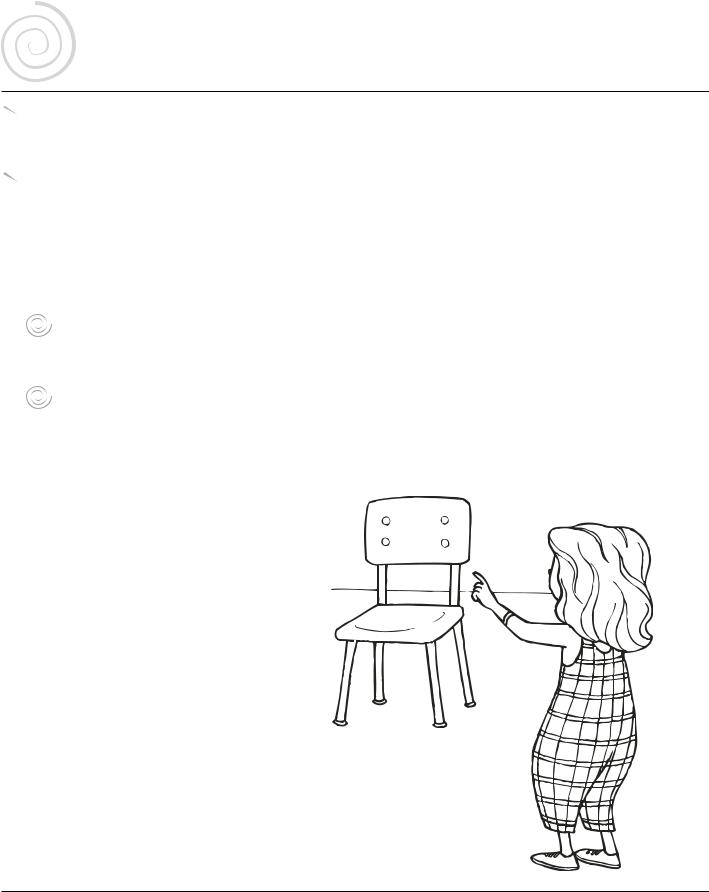
- •Table of Contents
- •Early Childhood Standards Correlation
- •Introduction
- •Crayon Poster
- •Shape Sandwiches
- •Here’s My Shape
- •Color Day
- •Breakfast Talk
- •Colorful Feelings
- •Find a Partner
- •Name the Missing Shape
- •Language and Literacy
- •The Story of a Circle
- •Anytime Egg Hunt
- •Who Can Find It?
- •Parking Garage
- •Scarf Pull
- •There’s a Word for That
- •Wheel Walk
- •Color Story
- •Big Book Time
- •Color Journal
- •Math
- •Green Things
- •In the Doghouse
- •Colorful Block Tower
- •Flannelboard Train
- •Match It
- •Paint Sample Matching
- •Block Play
- •Circle Sort
- •Secret Shapes
- •Take-Home Flannelboard Kit
- •Sandpaper Shapes
- •Shape Picture Cards
- •Shoe Sort
- •Treasure Maps
- •Neighborhood Picture Book
- •Do What I Do
- •Science
- •Food Color Chart
- •Shaker Bottle
- •Something Blue
- •Apple Exploration
- •Make a Rainbow
- •Bubbles Everywhere
- •Studying Leaves
- •Mixing Tints
- •Color Goo
- •Rainbow Pudding
- •Light Show
- •Rolling Along
- •Sun Prints
- •Tinted Ice Cubes
- •Music and Movement
- •Some Shoes
- •Color Train
- •Flag March
- •If Your Clothes Have Any Red
- •Here We Go
- •Do You Know What Shape This Is?
- •Color Binoculars
- •Red Light, Green Light
- •Body Shapes
- •Read the Notes
- •Circle Gets the Square
- •The Shapes Are on the Floor
- •Visual Arts
- •Recycled Rainbow
- •Shape Prints
- •Counting Collage
- •Marvelous Mobiles
- •Shape Flags
- •Shape Mural
- •Craft Stick Shapes
- •Motor Mural
- •Paper Bag Puppets
- •Bubbly Paint
- •Sun Catcher
- •Colored Sand
- •My Own Color Banner
- •Dramatic Play
- •Blanket Fold
- •Under the Sea
- •Color Photography
- •The Ice Cream Shop
- •Special Delivery
- •The Flower Market
- •Motor Skills
- •Get Into Shape
- •Just Like Me
- •Out the Door
- •Color Thumbkin
- •Shape Toss
- •Finger Dance
- •Moving Shapes
- •Roll a Triangle
- •Nail Shapes
- •Color Matching Board
- •Connect the Colors
- •I Can Make a Circle
- •Shape Sewing Cards
- •Rainbow Fruit Salad
- •String Shapes
- •Dough Shapes
- •Color Mixing
- •Pom-Pom Sort

Language and Literacy
10 ANYTIME EGG HUNT
 Materials
Materials
Plastic eggs
Small treats
 Activity
Activity
Fill plastic eggs with stickers, candies, or other little treats and scatter them in the children’s outside play area. (You will need at least one egg per child.) Instruct each child to find one egg. Ask the children to tell what color their egg is and where they found it. Then let them discover the treat hidden inside.
 Variation: Let the children take turns hiding the eggs.
Variation: Let the children take turns hiding the eggs.
11 WHO CAN FIND IT?
 Materials
Materials
Picture books
 Activity
Activity
Invite a small group of children to join you in a circle. Give each child a book to “read.” As the children look at the pictures, ask them to find a particular shape or color. For instance, you might ask, Can you find all the triangles? or Can you find all the yellow things? Give the children an opportunity to share their books with the group, showing the colors and/or shapes they have found.
© School Specialty Publishing |
15 |
1-57029-487-9 101 Colors and Shapes Activities |
M Graw-Hill Chi dren’s |

Language and Literacy
12 PARKING GARAGE
 Materials
Materials
Small toy cars
Shallow box
Pen
Scissors
 Activity
Activity
Conversation and play are some of the ways in which children develop vocabulary. This activity is ideal for inspiring reluctant talkers. Select several small toy cars. In the bottom of a shallow box, draw a “parking space” for each car in its matching color. Cut a garage door out of the box. Cut a “driveway” out of the lid. Then set the garage and cars in the block area. Join children as they practice parking the cars in the corresponding parking spots. Ask the children, How do you know where the cars go? What colors are the cars?
 Extension: Encourage the children to decorate their parking garage with traffic signs and other props.
Extension: Encourage the children to decorate their parking garage with traffic signs and other props.
13 SCARF PULL
 Materials
Materials
Pillowcase
Scarves in assorted colors
Chart paper
Pen
 Activity
Activity
Fill a pillowcase with scarves in various solid colors. (Thrift shops are a good source for inexpensive scarves.) At group time, let the children take turns reaching into the pillowcase, pulling out a scarf, and naming its color. Remind children not to peek! On chart paper, keep a tally of the scarves that are selected. Encourage the children to predict what color will be chosen next.
© School Specialty Publishing |
16 |
1-57029-487-9 101 Colors and Shapes Activities |
M Graw-Hill Chi dren’s |

Language and Literacy
14 I SPY
 Materials
Materials
No materials needed
 Activity
Activity
This traditional game promotes children’s oral language skills and vocabulary development. Have the children glance around the room as you call attention to objects of different colors. Then give a clue about one of the objects using the following format: I spy, with my little eye, something green. (A chair.) Let the children take turns guessing the object. Continue, giving plenty of clues, until children are able to play the game with confidence. Then let them take turns giving clues and guessing.
Tip: Encourage the children to give hints (that tell something more about the answer without giving it away). Giving hints can be tricky. As children are learning the art of hint-giving, they will sometimes say the answer. Be patient! It’s all a learning experience.
Variation: You can use this game to reinforce almost any basic concept. For instance, I spy . . .
something round (a clock), something huge (a tree), something tiny (a button).
© School Specialty Publishing |
17 |
1-57029-487-9 101 Colors and Shapes Activities |
M Graw-Hill Chi dren’s |

Language and Literacy
15 THERE’S A WORD FOR THAT
 Materials
Materials
No materials needed.
 Activity
Activity
When teaching children about shapes, remember not to oversimplify the words you use. Preschoolers enjoy learning sophisticated words, and an early introduction to math vocabulary benefits them when they begin formal math education. For instance, if a child calls a square a rectangle, do not correct him or her. Instead, point out that a square is a type of rectangle that has four equal sides. Use the terms, side, tip, or corner when describing geometric shapes.
Extension: Print the children’s favorite shape words on a word wall in your classroom. The words can be illustrated with children’s drawings or with pictures cut from magazines.
For Older Children: Provide the children with shape journals where they can record their favorite shapes and shape words.
Variation: Set aside classroom space for a color word wall. When the children learn a new color word, print the word (in a corresponding color of ink) on a piece of paper and add it to the wall. Include exotic color names learned from the crayon box or from books. Older children can sort the color words according to initial letter. Challenge them to find a color that begins with the same letter as their first name.
© School Specialty Publishing |
18 |
1-57029-487-9 101 Colors and Shapes Activities |
M Graw-Hill Chi dren’s |
